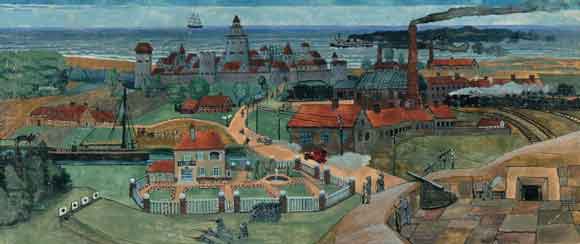Jung’s childhood daydreams

Image taken from Carl Jung’s Liber Novus (‘The Red Book’), 图片来自的《红书》
and explained by psychological historian Sonu Shamdasani.
在他37岁那年,瑞士临床心理学家,的创立者卡尔·荣格觉得自己迷失了生命的意义。据心理史学者Sonu Shamdasani(伦敦大学)说,他触及到了有关存在的危机,在那里,他只不过是忽视了终极关怀的精神领域,那儿是他年轻时的主要动力。
Over the coming years, Jung engaged in a process of self-experimentation which he himself termed a ‘confrontation with the unconscious’. It took the form of provoking an extended series of waking fantasies in himself, and then attempting to understand them psychologically. He called this the method of ‘active imagination’, and developed it as psychotherapeutic method. Drawing from these materials, he composed a work of psychology in a red leather journal which he illustrated with his own paintings, continuing to work on it up to 1930.
随后的几年,荣格进行了体验,这被他称之为“与的遭遇”。它采取的形式是刺激自己一系列的清醒的幻想,然后试图在心理上去理解他们。他称之为“积极想象”的方法,并且将其发展成为了治疗的方法。他将这些材料编排成了一本红色的皮革杂志,在此之中,他用自己的画加以说明,这项工作一直持续到1930年。
Professor Shamdasani got hold of a copy in 1996, and after years seeking to understand it and convince the Jung family to allow its publication, he translated Jung's words into English and added an introduction and extensive footnotes. First published in 2009 by W.W. Norton, it was one of the most influential unpublished works in the history of psychology.
Shamdasani教授在1996年得到了一份副本,并且经年努力去理解它,并说服Jung家族允许其出版,他把Jung的话翻译成英文,同时增加了一个以及大量的脚注。首次由诺顿出版社于2009出版,这本书是心理学史上最具影响力的未发表的作品之一。
This image represents one of Jung’s fantasies in his childhood in which he saw Alsace being submerged by water and Basle turned into a port. ‘I approach these as a historian,’ Shamdasani says, ‘so I refrain from speculation or interpretation of the images. It's clear that Jung thought about each element of these images, and sometimes said it would take him many years to figure out what they actually meant.’
此图呈现了荣格童年期的幻想,他看到阿尔萨斯被水淹没,巴塞尔变成了一个港口。 “我用历史学家的方法来看待它,”Shamdasani说,“所以我避免从图片中猜测或解释。很明显,Jung思考了这些图像中的每一个元素,甚至有时候他要花很多年才能弄清楚它们的真正含义。”
‘To the superficial observer, it will appear like madness,’ Jung wrote. Yet Shamdasani says ‘there wasn't anything like a psychosis’. Indeed, the images and ideas in ‘The Red Book’ were perhaps the foundation of Jung’s theories on archetypes, the collective unconscious, and the process of individuation – the journey one must undertake in order to become an individual.
Jung写道:“对于肤浅的观察者而言,这看上去很疯狂,”然而,Shamdasani说,“没有什么像个”。事实上,在“红书”中的图画和思想也许是Jung关于原型、集体无意识和个性化——成为一个人必须经由旅程的理论基础。



